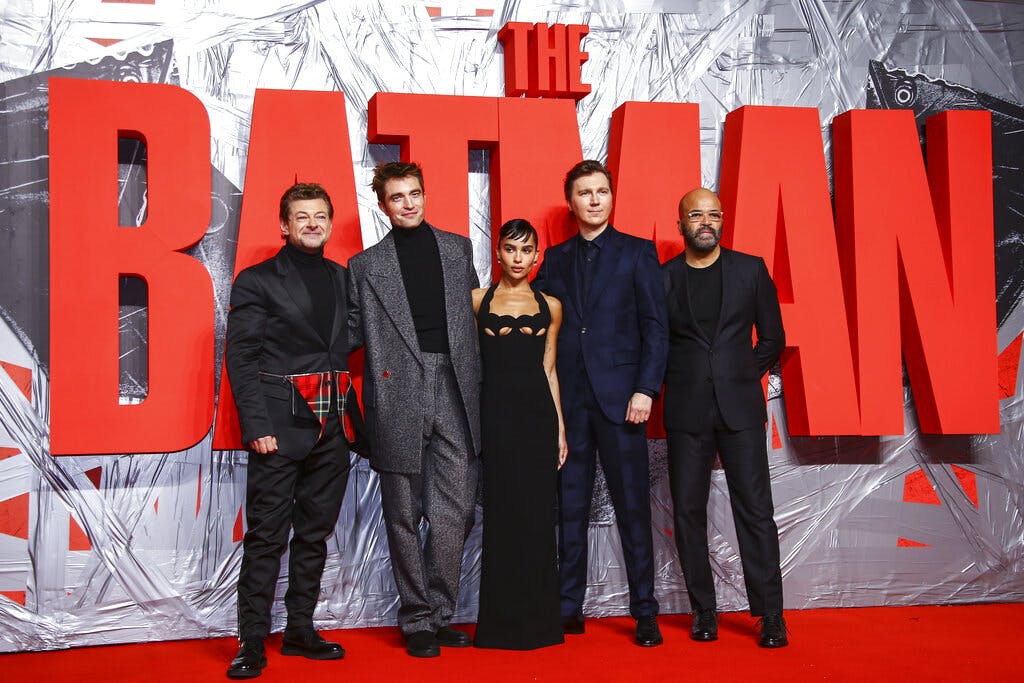Stuck Deep in a Rabbit Hole With ‘The Batman’
The more naturalistic this superhero-and-villain universe becomes, the less idiosyncratic and fresh it feels.

How dark is too dark: When one must squint to see the choreographed fisticuffs of a fight scene? When the “sins of the father” theme comes down for the umpteenth time? In the case of “The Batman,” the search for that answer raises another question: “Why am I watching this movie?”
The Batman comic book character first took flight in 1939, a few months before the start of World War II. From the start, he was violent with criminals and low-lifes, driven by the murder of his parents. The urban world that was presented in the cubes, rectangles, and slivers of action was bleak despite the colorful palette.
As the character evolved over eight decades, there have been a few humorous incarnations, like Adam West’s in the 1960s “Batman” television series, but for the most part the character became gloomier and the color scheme of Gotham City murkier as the years passed, especially with the introduction of the “Dark Knight” comic books in 1986.
Cinematically, the first A-list Batman movies from the late 1980s and early ’90s combined both the light and the dark. Directed by the master of the mildly macabre, Tim Burton, both “Batman” and “Batman Returns” were grand entertainments, with imaginatively imposing sets, colorful lighting that complemented the constant nighttime, riveting action, witty scripts, and fantastic actors such as Michael Keaton, Jack Nicholson, and Michelle Pfeiffer.
Then came the two movies directed by Joel Schumacher that attempted to return the character and his milieu to the campiness of the earlier TV series, with minimal critical and commercial success. “The Dark Knight” trilogy directed by Christopher Nolan upped the bleakness considerably, with dimly lit scenes, death and violence galore, and barely audible dialogue. At least the middle film, 2008’s “The Dark Knight,” had the truly frightening portrayal of the Joker by Heath Ledger and a real philosophical bent, albeit grim.
The latest “The Batman,” with the definite article included for emphasis, draws heavily from the Nolan trilogy — with diminishing returns. Right from the opening murder scene, the cinematography is entirely too dark, with the viewer having little sense of the scale and detail of the space in which it takes place.
As barely lit scenes follow shadowy ones, it all becomes nearly sleep-inducing, especially since the main plot involves city corruption and mafia machinations that aren’t terribly interesting or original. Connected to this storyline is the evil Riddler, who grotesquely dispatches a couple people, a la the serial killer movie “Seven,” but since he and the unlucky characters he kills barely comes into focus, it’s hard for the audience to care. All of it is dark, dreary, and devoid of distinction.
As directed and co-written by Matt Reeves, known for the recent “Planet of the Apes” movies, this new “Batman” eschews much of the character embellishments of prior movies, so there are no loving shots of Batman’s accoutrements, no exposition about Catwoman’s inspiration beyond having a lot of cats around, and no basis for the character of The Penguin to be so-called except for his body shape and beaky nose.
The more naturalistic this superhero-and-villain universe becomes, the less idiosyncratic and fresh it feels. Why watch this when you could be watching a film noir from the 1940s and enjoying snappier dialogue, sharper characters, and twistier scenarios served with a healthy helping of sunless cynicism?
Did I mention that the movie is just shy of three hour long? With the first two hours taken up by the convoluted corruption plotline — to no one’s surprise, “the rat” is finally revealed — another hour is awkwardly added that further involves the Riddler and includes a perfunctory apocalyptic set piece because, well, every comic book movie needs one.
The viewer’s patience might have been more forgiving of this part if every prior scene hadn’t been several beats too slow, and if we had been let in on the planning of this great disaster beforehand. But we have been left in the dark yet again.
Submitting to the general glumness of the movie, most of the actors hardly make an impression — certainly not Robert Pattinson as the lead or Paul Dano as the Riddler. Only Zoë Kravitz as Catwoman generates a few romantic sparks and frissons of class warfare.
Similar to the Batman universe-adjacent “The Joker” from 2019, the movie would like to think it’s making a disturbing statement about modern-day issues like crime, police corruption, inequality, and even mental health. What it’s saying though, repeatedly and none-too-subtly, is that the patriarchy is to blame, and the cycle of violence will never be broken.
While one is hard-pressed to deny the power of this argument, it makes us long for an evil mom or two, and a movie that ends not with a bang but a glimmer of hope. This one ends in a prison, hinting at a sequel with even more death and destruction. Here’s hoping it’s better — and brighter — than “The Batman.”

